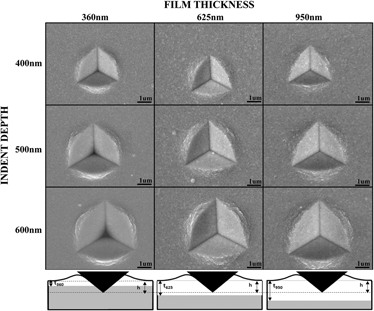Published online by Cambridge University Press: 23 June 2015

This work focused on ascertaining the effect of pile-up during indentation of thin films on substrates. Conventional understanding has postulated that differences in contact area resulting from pile-up or sink-in significantly alter the extraction of material properties. In this work, the specific case of pile-up with compliant, plastically deforming films on stiff, nonplastically deforming substrates was studied. Several literature methods to assess pile-up were leveraged, and a new technique was developed and validated to quantify projected pile-up. Indentation testing was performed on gold films of multiple thicknesses on several ceramic-based substrates. The results indicated that the degree of pile-up was solely a function of indent depth into the film. Pile-up was not influenced by film thickness or substrate elastic modulus. In other words, the pile-up development was insensitive to the presence of the substrate and how it contributes to the composite's elastic properties. In such case, if the elastic response of the film/substrate composite was independent of the degree of pile-up, then elastic data acquired from unloading did not require a contact area correction. The findings are confirmed using the Zhou–Prorok model for extracting film elastic properties for both gold and platinum films.